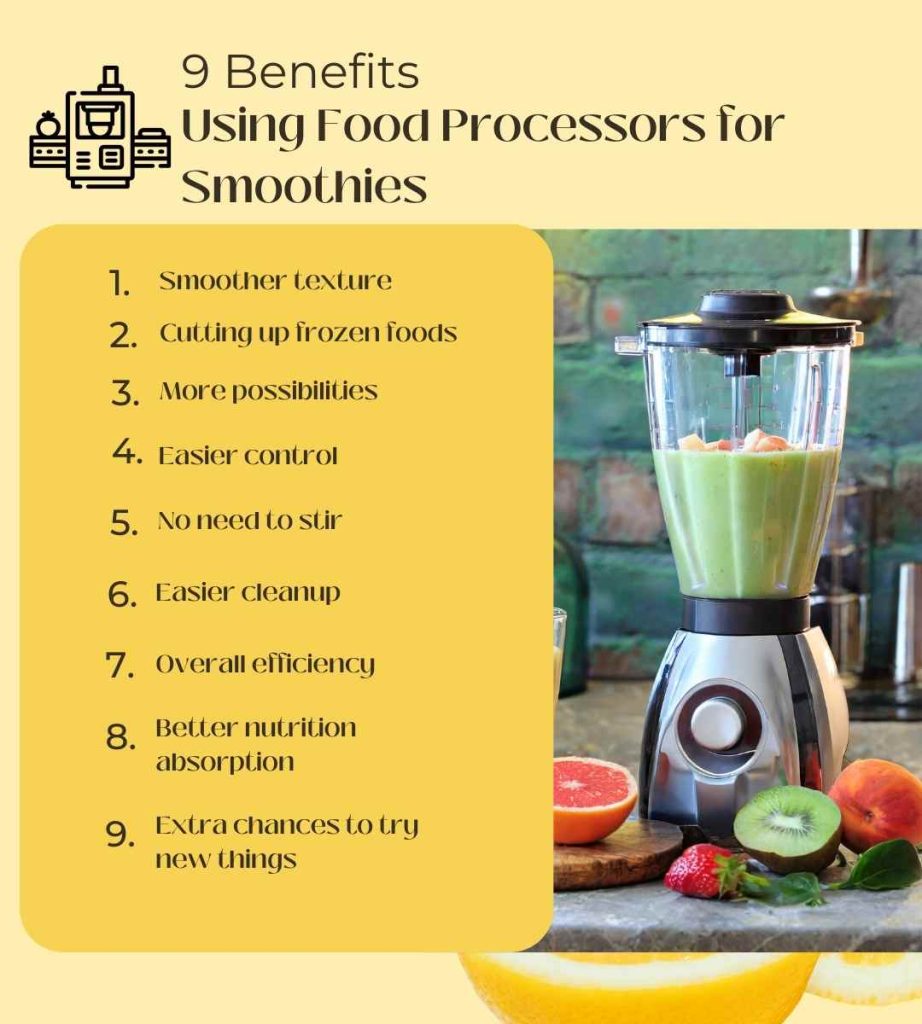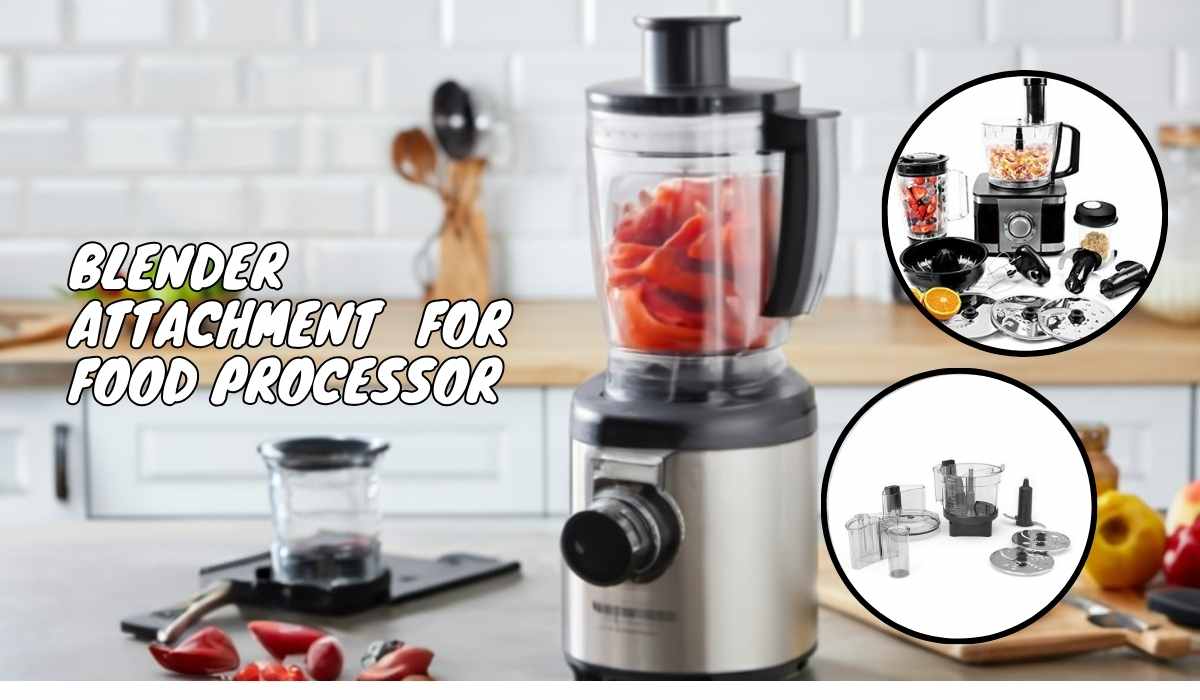Greetings to a world full of magic and variety in the kitchen! In my analysis, it is recommended that the powerful food processor is the secret tool of any serious cook who wants to make delicious drinks. . Although it looks like just another tool – the food processor is a powerhouse. There are a lot of benefits of using food processors for smoothies. As it makes smoothies easy, quick, and enjoyable.
In my research guide, I’ll go over all the great reasons why using a food processor to make the perfect smoothies is highly recommended. I also show you how these cooking marvels take your mixing game to new heights in terms of- speed, efficiency, versatility, and maintaining nutrients.
Come with me, I will talk about the amazing benefits and clever features that make food processors an essential tool for anyone who wants to make delicious, healthy smoothies with the utmost ease.
Benefits of Using Food Processors for Smoothies (9 Factors)

When it comes to making smoothies, food processors are better than blenders in a number of ways:
Smoother texture (1):
Compared to blenders, food processors have stronger blades and motors. This can easily crush even the hardest ingredients, making smoothies smoother and silkier. This will help your smoothie a lot if you use frozen fruits or fresh veggies.
Cutting up frozen foods (2):
Food processors are great at cutting up frozen fruits and veggies, while some blenders find it hard to do. You can add frozen foods to your drink without first letting them thaw, which saves time and keeps the benefits.
More possibilities (3):
Food makers come with different tools and blades that let you do more than just make smoothies. They’re good for chopping nuts and seeds, grating cheese, making dips and sauces, grinding spices, and even working dough. They are useful in any home because they can be used for many things.
Easier Control (4):
Food processors have a bigger feed tube than blenders. It makes it easier to add items without having to chop them first. Some models also have speed levels that you can change. It gives you more control over how thick your smoothie is.
No need to stir (5):
Food processors have a built-in scrape device that moves ingredients toward the blades automatically, so you don’t have to stop and stir the mixture while it’s mixing. This function can come in handy when making a lot of drinks at once.
Easier cleanup (6):
Cleanup is easier because many food processors have parts that can go in the dishwasher. This makes cleaning up quick and easy.
Overall efficiency (7):
When making smoothies, food processors can be faster and more efficient than blenders, especially when using frozen items or making a lot of them at once.
Better nutrition absorption (8):
Food processors can help your body absorb more nutrients from fruits and vegetables by breaking them down into smaller pieces.
Extra chances to try new things (9):
Food machines make it easy to chop and grind different items, so you can make more varied and unique smoothie recipes. If you have extra items, a food processor can help you use them up by adding them to drinks.
Though, it’s worth keeping in mind that food makers aren’t always the best way to make smoothies. They might take up more space and cost more than blenders, and they might not be as good at making textures that are foamy or airy.
NB: The best tool for making smoothies relies on what you want and need. A food processor might be a good choice for you if you like a smooth and uniform taste, a lot of different uses, and quick and easy use.
Why Is A Food Processor Useful – Know Easily
A food processor is a versatile kitchen appliance that offers a wide range of benefits, making it a valuable addition to any kitchen.
Here are some key reasons why a food processor is useful:
- Saves time and effort
- Creates smooth and consistent textures
- Versatility
- Improved nutrient absorption
- Reduces food waste
- Easy to use
- Dishwasher-safe parts
- Prepares large quantities
Potential Downsides Before Purchasing A Food Processor
But it’s important to think about some possible problems before buying a food processor:
- Cost: They may be more expensive than machines that only do one thing, like blenders or choppers.
- Size: It may take up useful table and storage room.
- Not the best for small amounts: It could be too much for small meals or one dish. It can only hold a small amount of liquid, so it’s not good for mixing large amounts of food, like shakes.
Overall, how useful a food processor is for you depends on what you need it for and how you usually cook. If you want to save time, be more flexible, and make cooking easier, a food processor might be a good buy. It might not be the best choice for you. Though, if you only cook small meals or don’t have much storage room.
Food Processor Advantages And Disadvantages- Comparison Table
Follow the table below:
Here’s is a Food Processor Advantages and Disadvantages Comparison Table:

To sum up:
People who cook at home can save time and effort by using a food processor, which can also make tastes smooth and do many other things. But before you buy them, you should think about their size, cost, and what jobs they can’t do.
In the final analysis, your wants, cooking habits, and finances will determine whether you should buy a food processor.
Can You Use A Food Processor As A Blender For Smoothies
Yes, you can . You may also follow the following guidelines.
Here are some steps for using a food processor to make smoothies:
- Step 1: First, use the cutting blade, the results will be smoothest.
- Step 2: Adding the liquids first will make it easier for the blades to move the items around.
- Step 3: You should start with the lightest ingredients. This will help the blades cut everything up evenly.
- Step 4: Pulse instead of mixing all the time. This will let you change the color more easily.
- Step 5: Adding frozen fruits and vegetables will help the smoothie get thicker and taste better.
- Step 6: Blend the drink first, then add ice if you want it smoother.
- Step 7: For the ingredients to get mixed in, scrape down the sides of the blender often.
If you want to make smoothies, you can use a food processor as a mixer, but it depends on your unique taste.
NB: A food mixer can be a good option if you don’t mind a smoothie with a bit more chunks and less air. But if you want a drink that is perfectly smooth and foamy, you should use a blender.
Deciding Between Benefits Of Food Processor And Blender: Which Is The Better Choice?
It can be hard to decide between a food processor and a blender because each has its own pros and cons that depend on your needs and tastes. You also make idea on juicer and food-processor.
To help you decide, here’s a list:
The best choice comes down to your own wants and goals in the end:
- A food processor is the best tool for you if you want to be able to do a lot of different things quickly and easily.
- A blender is a better choice if you only need to make drinks, soups, and sauces in small amounts. It will also save you money and space.
- A blender is better if you want perfectly smooth textures and want the machine to be quiet.
To make an informed choice, think about your income, how often you cook, and your go-to meals. If your income and kitchen room allow it, you might even want to buy both tools to make your cooking options even wider.
Final Say
Food processors are great for making smoothies that are both tasty and good for you. Most people still choose blenders, but food processors can be great in some cases and have their own benefits.
Food makers are great for making smoothies, but they can’t do everything:
- Since they are bigger than blenders, they take up more store room.
- As they cost more, they might not be right for everyone.
- They might not make smoothies as airy as some other blenders do.
Food mixers are great for making drinks that are smooth, tasty, and full of nutrients. They are especially useful for chefs who like to be in charge, be flexible, and work quickly. Even though they aren’t perfect for everyone, they are a great choice to regular blenders that can help you try new foods and make smoothies more fun.
FAQs
Can You Make Smoothies In A Food Processor?
You can make smoothies in a food processor, but the texture might not be as smooth as with a powerful blender. You can mix fruits and veggies in a food processor, but the taste might not be as smooth as it is in a blender. But food mixers are flexible, and they can still mix smoothie ingredients well.
Why Not Use A Blender Instead Of A Food Processor?
Food mixers and blenders are not the same thing. In a food processor, you can chop, slice, grate, and mix dough. In a blender, on the other hand, you can blend liquids to make better textures, which makes them perfect for smoothies, soups, and purees.
Which Is Better? A Food Processor Or A Hand Blender?
Depending on what you want to do, you can use either a hand blender (also called an immersion blender) or a food processor. Hand blenders work best for mixing small amounts of food right in a jar or pot. Food mixers, on the other hand, are better for bigger batches and can do more than just blend food.
Can I Mix Things In A Food Processor?
Yes, you can mix different things in a food processor, like pancakes, recipes, and sauces. A food processor’s mixing blades or devices make it easy to mix items together. This makes it a useful tool for many mixing jobs in the kitchen.
Can I Use A Food Processor To Puree?
Yes, food makers are great for making purees out of food. Their blades are very strong and can blend cooked fruits, veggies, and other foods into a smooth puree that can be used in soups, sauces, baby food, and other things.
What Shouldn’t Go Into A Food Processor?
You can use a food processor for many things, but there are some things you shouldn’t put in it. Avoid things like very hot liquids (they could splash), very hard things like ice cubes (they could damage the blades), and big chunks of very hard food (they could strain the motor). Additionally, delicate items such as herbs may get over-processed or damaged in a food processor.
Always check the user manual for your individual device for instructions on what not to put in it so that it lasts longer and is safer to use.
These answers should help you understand the differences between blenders and food processors and how to use each one and different benefits. They should also tell you what you can and can’t put in a food processor.

Tammy E. Edison is a distinguished specialist in the world of kitchen appliances, and she is proud to be a part of the dynamic team at kitchenusers.com. With a background in engineering and a passion for culinary innovation, Tammy E. Edison has established herself as a go-to expert for all things related to kitchen appliances technology.


